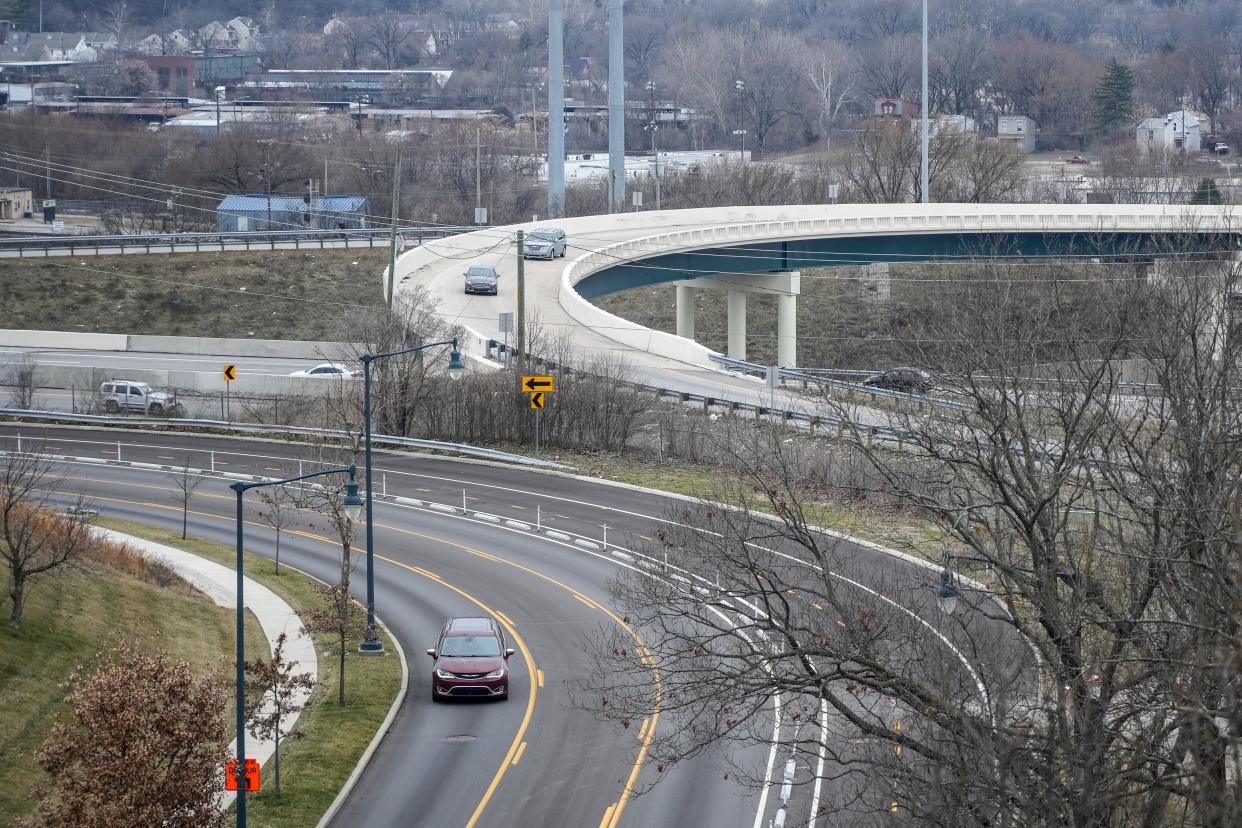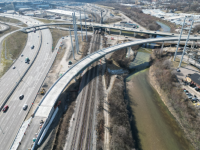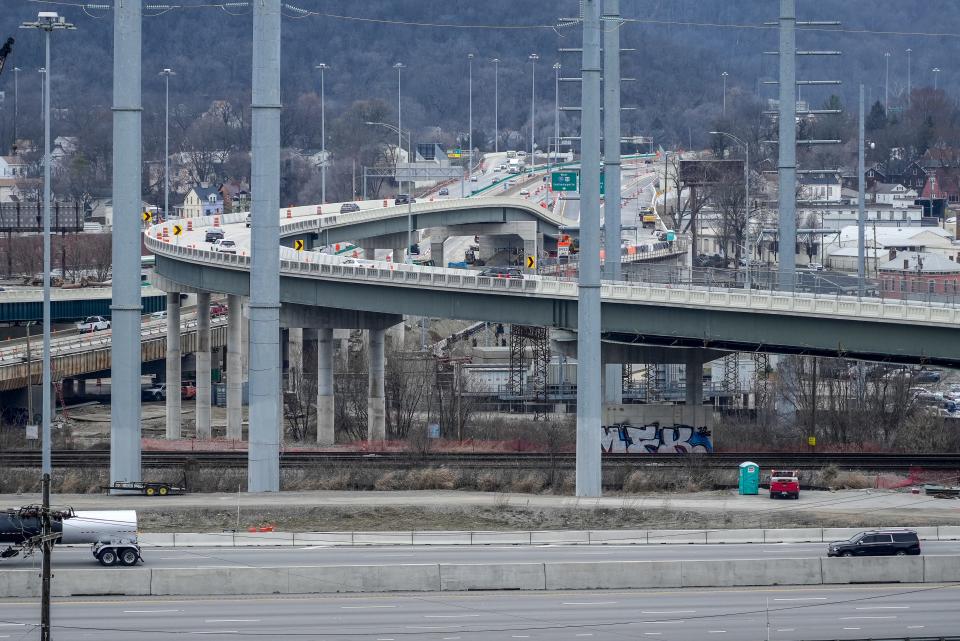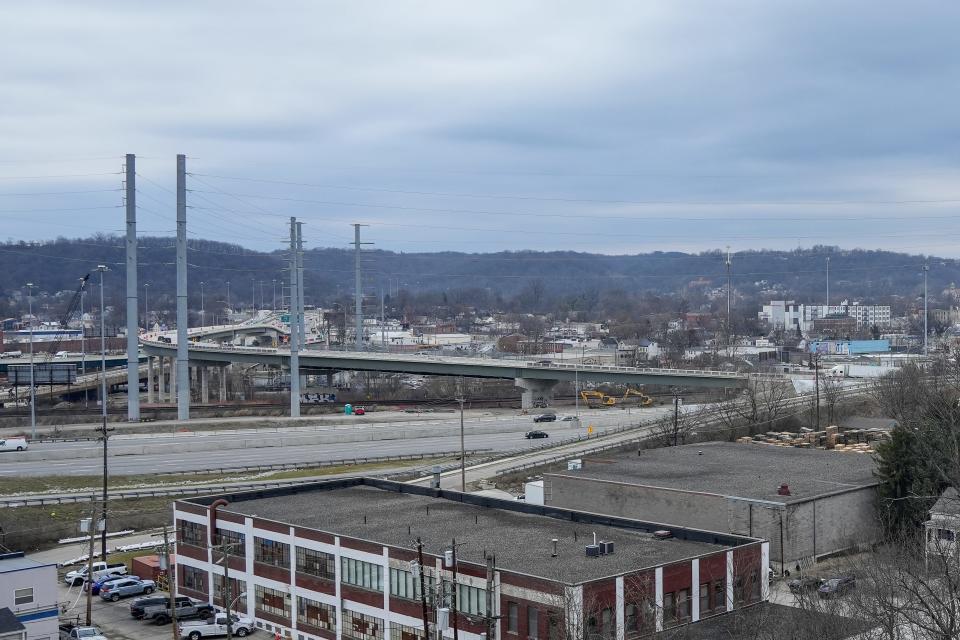Get ready for sky-high 'new traffic pattern' from I-75 to I-74

Signs tell drivers traveling south on Interstate 75, heading for westbound Interstate 74, to expect a “new traffic pattern.”
They aren’t kidding.
The just-opened ramp from I-75 to I-74, located near Clifton's Cincinnati State Technical and Community College, is new on several counts – its height, its turn and its length.
The ramp project, at $85 million, is part of the larger, multiyear Mill Creek Expressway work. While still marked with orange barrels and signs – and some finishing touches yet to come – the interchange has been open to vehicles since Sunday.
At its highest point, the new "flyover bridge ramp" from I-75 south rises 85 feet above Mill Creek and 67 feet above Spring Grove Avenue before descending to connect with I-74.

But while the ride up and over the ramp feels a bit like a roller coaster, albeit at just 35 mph, it doesn't rank high for its height. For comparison:
The tallest building in Cincinnati is downtown's Great American Tower at 665 feet.
The tallest bridge in Ohio is Interstate 71's Jeremiah Morrow Bridge in Warren County at 239 feet.
The tallest flyover bridge ramps in the country are mostly in the South, with a 120-foot ramp in Orlando, Florida; a 130-foot one in Los Angeles; and a 140-foot one in Dallas.
The new local ramp itself runs 1,872 feet, while the span from I-75 to the exit at Beekman Street and Colerain Avenue/U.S. Route 27 is just shy of a mile at about 5,000 feet.
The flyover ramp replaces a street-level interchange from southbound I-75 to westbound I-74 that included a sharp curve and traveled under a railroad bridge. That interchange also served drivers heading to I-74 from northbound I-75, creating hazardous bottlenecks at the Beekman/Colerain exit.
Just past the old interchange, I-74 travels 40 feet above Mill Creek and 23 feet over Spring Grove – so about half as high as the new ramp takes drivers.

In addition to the ramp, this part of the Mill Creek project included:
A new through-lane on westbound I-74 between I-75 and Montana.
Bridges over Spring Grove, Beekman and Elmore Street.
Rehabilitation of a pedestrian bridge over I-74, at Powers Street just east of the Beekman exit.
Still to come this year will be new lighting, median barriers, signs and noise walls.
About 14,350 motorists travel through that interchange every day, according to state transportation data. That's about on par with the number moving from both I-71 and I-75 onto I-275, which range from 12,000 to 16,000 a day.
Mill Creek Expressway project includes 12 phases
The entire Mill Creek project, with an estimated total cost of $550 million to $650 million, includes 12 phases. Already complete are:
Widening and resurfacing of I-75 between Western Hills Viaduct and Monmouth Street; reconstruction of the interchange at I-75 and Hopple Street; and removal of a pedestrian bridge over Central Parkway, for $90.6 million.
Widening I-75 and connecting it to Hopple and Mitchell street improvements, for $86.9 million.
Reconstruction of an interchange at I-75 and Mitchell Avenue, at $53.7 million.
Widening and resurfacing of I-75 from the Mitchell Avenue interchange to Ohio 562, known as the Norwood Lateral, and reconstruction of a bridge over Vine Street on I-75, for $31 million.
Replacement of the Indiana Ohio Railway Bridge over I-75, just south of the Norwood Lateral, for $18 million.
Reconstruction of the Colerain and Beekman interchange, with a new ramp from Beekman to westbound I-74 and elimination of ramps from I-74 to Spring Grove, with a $13.3 million price tag.
Preliminary engineering work and acquisition of property in the right-of-way, at $10.9 million.
Replacement of Seymour Avenue bridge and reconstruction of parts of Paddock Road bridge over I-75 in preparation for other coming improvements, for $7.6 million.
Conversion of Monmouth Street (between Colerain Avenue and Central Parkway) from an overpass to a through street and removal of Bates Street overpass and bridge, for $6.8 million.
Demolition of buildings near the Hopple interchange to prepare for other work, for $1.8 million.

Still ahead is final Mill Creek work, plus Norwood Lateral
Still to come as part of the Mill Creek work is a $121.6 million project to widen and resurface I-75 between Norwood Lateral and the Ronald Reagan Highway (State Route 126).
That project, starting this spring and continuing through next spring, will include the reconstruction of an interchange at I-75 and the Norwood Lateral; improvements at the Paddock Road interchange; and related work.
At the same time, in a separate project, the state will be rehabbing the Norwood Lateral. That $21.4 million project will close parts of the highway from mid-March to mid-September, with related work lasting until June 2025.
Traveled the new flyover bridge ramp yet? Tell us what you think at pnewberry@enquirer.com.
This article originally appeared on Cincinnati Enquirer: How high is the new ramp from I-75 to I-74?

